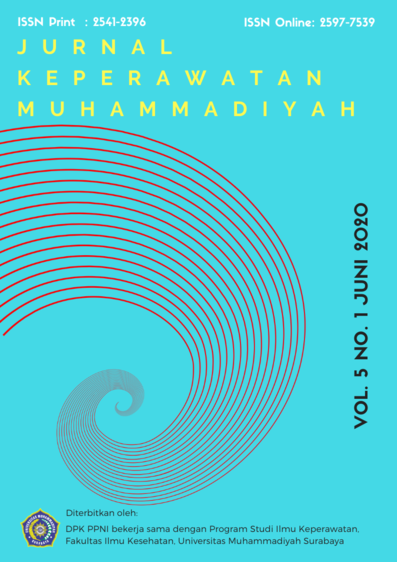Analisis Kebutuhan Pelayanan Komplementer di PMB Wilayah Surabaya
DOI:
https://doi.org/10.30651/jkm.v5i1.15140Keywords:
practice, midwife, complementaryAbstract
Objective: Currently, midwives have implemented complementary and alternative medicine in the practice of midwifery services. Midwives argue that complementary therapies can help reduce medical interventions and as a means to empower women. This is consistent with the principles of midwifery, which state that childbirth is a natural process and there is a role for the midwife in facilitating support and options for women. This condition is a separate phenomenon for further research. The purpose of this study is to analyse the need for complementary services in PMB Surabaya.
Methods: The research used the survey method through the preparation stage, data collection, processing, and analysis of the results. The research subjects are community and midwives who practice complementary midwifery services. Samples were taken through a purposive sampling technique. Quantity data in the frequency distribution table and cauldron data are presented in an interactive model. Data is analysed and presented quantitatively in the form of a frequency distribution.
Results: The study’s results explain that most of the respondents are 36-45 years old (53.3%), have the latest education in DIII Midwifery, 11-20 years of practice (46.7%), and most of them have attended seminars/training on services complementary obstetrics.
Conclusion: The analysis of the need for complementary services in the Independent Midwife Practice (PMB) in Surabaya was done mainly by massage therapy, with as many as seven midwives (46.7%). Massages performed by midwives include baby massage, breast massage, and oxytocin massage. Other complementary therapies are yoga (26.7%), hypnotherapy (20.0%), and herbal medicine (6.7%).
References
Darwin, C. (2017). Building a learning organization. Knowledge Solutions, 57.
Ekasari, M. F., Riasmini, N. M., & Hartini, T. (2019). Meningkatkan kualitas hidup lansia konsep dan berbagai intervensi. Wineka Media.
Ernst, E., & Watson, L. K. (2012). Midwives’ use of complementary/alternative treatments. Midwifery, 28(6), 772–777.
Gaffney, L., & Smith, C. A. (2004). Use of complementary therapies in pregnancy: the perceptions of obstetricians and midwives in South Australia. Australian and New Zealand Journal of Obstetrics and Gynaecology, 44(1), 24–29.
Guerrera, M. P. (2012). Chapter 11 - Complementary and Alternative Medicine: Integration into Primary Care. In R. E. Rakel & D. P. Rakel (Eds.), Textbook of Family Medicine (Eighth Edition) (pp. 131–145). W.B. Saunders. https://doi.org/https://doi.org/10.1016/B978-1-4377-1160-8.10011-9
Hashimoto, H., Matsuura, T., & Ueta, Y. (2014). Fluorescent visualization of oxytocin in the hypothalamo-neurohypophysial system. Frontiers in Neuroscience, 8, 213.
Hastings-Tolsma, M., & Terada, M. (2009). Complementary medicine use by nurse midwives in the US. Complementary Therapies in Clinical Practice, 15(4), 212–219.
Hepilita, Y., & Saleman, K. A. (2019). Pengaruh penyuluhan kesehatan terhadap tingkat pengetahuan diet hipertensi pada penderita hipertensi usia dewasa di Puskesmas Mombok Manggarai timur 2019. Wawasan Kesehatan, 4(2), 91–100.
Hirschkorn, K. A., & Bourgeault, I. L. (2008a). Structural constraints and opportunities for CAM use and referral by physicians, nurses, and midwives. Health:, 12(2), 193–213.
Hirschkorn, K. A., & Bourgeault, I. L. (2008b). Structural constraints and opportunities for CAM use and referral by physicians, nurses, and midwives. Health:, 12(2), 193–213.
James, P. B., Wardle, J., Steel, A., & Adams, J. (2018). Traditional, complementary and alternative medicine use in Sub-Saharan Africa: a systematic review. BMJ Global Health, 3(5), e000895.
Kementerian Kesehatan RI. (2021). PROFIL KESEHATAN INDONESIA TAHUN 2020.
Koc, Z., Sağlam, Z., & Topatan, S. (2017). Determination of the usage of complementary and alternative medicine among pregnant women in the Northern Region of Turkey. Collegian, 24(6), 533–539.
Kostania, G. (2015). Pelaksanaan Pelayanan Kebidanan Komplementer Pada Bidan Praktek Mandiri Di Kabupaten Klaten. Gaster, 12(1), 46–72.
Krebs, L. U. (2015). Mind-body interventions. Oncology Nursing Society.
Kwahk, K.-Y., & Park, D.-H. (2016). The effects of network sharing on knowledge-sharing activities and job performance in enterprise social media environments. Computers in Human Behavior, 55, 826–839.
Levett, K. M., Smith, C. A., Bensoussan, A., & Dahlen, H. G. (2016). The complementary therapies for labour and birth study making sense of labour and birth–experiences of women, partners and midwives of a complementary medicine antenatal education course. Midwifery, 40, 124–131.
Lindquist, R., Tracy, M. F., & Snyder, M. (2018). Complementary and alternative therapies in nursing. Springer Publishing Company.
Neubauer, B. E., Witkop, C. T., & Varpio, L. (2019). How phenomenology can help us learn from the experiences of others. Perspectives on Medical Education, 8(2), 90–97.
Notoatmodjo, S. (2007). Promosi kesehatan & ilmu perilaku.
Notoatmodjo, S. (2012). Metodologi penelitian kesehatan.
O’Regan, P., Wills, T., & O’Leary, A. (2010). Complementary therapies: a challenge for nursing practice. Nursing Standard (through 2013), 24(21), 35.
Pairman, S., Tracy, S. K., Thorogood, C., & Pincombe, J. (2010). Midwifery: preparation for practice. Elsevier Health Sciences.
Saputri, N. (2019). Pentingnya manfaat pijat bayi pada bayi usia 0-12 bulan. Dinamisia: Jurnal Pengabdian Kepada Masyarakat, 3.
Sukmawati, E., Kesehatan, N. I.-J., & 2020, undefined. (2020). Efektivitas Pijat Bayi terhadap Peningkatan Kualitas Tidur Bayi. Jurnal Kesehatan Al-Irsyad, 13(1). http://www.e-jurnal.stikesalirsyadclp.ac.id/index.php/jka/article/view/49
Tharpe, N. L., Farley, C. L., & Jordan, R. G. (2021). Clinical practice guidelines for midwifery & women’s health. Jones & Bartlett Learning.
Utami, L. S. S. (2015). Teori-teori adaptasi antar budaya. Jurnal Komunikasi, 7(2), 180–197.
Williams, J., & Mitchell, M. (2007). Midwifery managers’ views about the use of complementary therapies in the maternity services. Complementary Therapies in Clinical Practice, 13(2), 129–135.
Downloads
Published
Issue
Section
License
- Penulis tetap memegang hak atas karyanya dan memberikan hak publikasi pertama kepada jurnal ini yang secara simultan karya tersebut dilisensikan di bawah:Â Creative Commons Attribution-ShareAlike 4.0 International (CC BY-SA 4.0)













